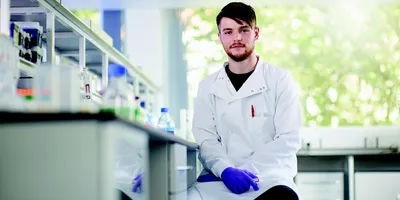By the end of this century, permafrost in the rapidly warming Arctic will likely emit as much carbon dioxide and methane into the atmosphere as a large industrial nation, and potentially more than the US has emitted since the start of the industrial revolution.
But that’s only one possible future for the vast stores of carbon locked in the formerly perennially frozen but now-thawing ground in the Arctic. Using over a decade of synthesis science and region-based models, a new study led by Northern Arizona University and the international Permafrost Carbon Network and published in Annual Review of Environment and Resources forecasts cumulative emissions from this “country of permafrost” through 2100 under low, medium, and high warming scenarios.
“We hope that these forecasts of future Arctic carbon emissions not only update the scientific picture but act as new guide rails for policymakers who are working to stabilize the climate and avoid exceeding temperature targets,” said Ted Schuur, Regents’ professor in the department of biology and Center for Ecosystem Science and Society at NAU and lead author of the study.
The team estimates that under a low warming scenario—one that could be achieved if the global community limited warming to 2°C or below by reducing fossil fuel emissions—permafrost would release 55 petagrams (Pg) of carbon by the end of the century in the form of greenhouse gases carbon dioxide (CO2) and methane (CH4). If nothing is done to mitigate climate warming, the study estimates the Arctic could release 232 Pg of carbon by the end of the century.
The team’s projections go beyond previous international forecasts by accounting for hydrological and biogeochemical dynamics and tipping points unique to the permafrost zone.
For instance, scientists are witnessing abrupt thaw in many permafrost regions, where rapid melting of ground ice in permafrost causes the land surface to collapse, forming lakes or other changes to surface hydrology. Once formerly frozen ground erodes or subsides, the carbon stored there can enter the atmosphere via microbial respiration or methane. Such rapid, non-linear shifts quickly and permanently change permafrost’s ability to store carbon and could toggle large swaths of the Arctic region from carbon sinks to carbon sources. Recent estimates suggest that one-fifth of current permafrost terrain is vulnerable to abrupt thaw.
“Once permafrost carbon emissions increase in response to climate warming as some models predict, there won't be a way for us to stop that process,” said Roisin Commane, assistant professor of Earth and environmental sciences at Columbia University and co-author of the new study. “We may need to reduce our fossil fuel emissions much sooner than currently planned by many governments to avoid triggering possible tipping points in Earth’s climate.”
The potential to cross both regional and system-wide tipping points is one reason the story of Arctic carbon and its future security remains only partially written. The new study describes nine different futures based on how climate warming progresses and what actions global leaders take to reduce fossil fuel emissions.
“Permafrost emissions will be a large and substantial contributing factor to atmospheric greenhouse gases, no matter which of the possible scenarios becomes reality,” said Guido Grosse, head of the permafrost research section at the Alfred Wegener Institute in Potsdam, Germany and co-author of the study. “But there will be huge differences between mitigation scenarios that matter to the overall global carbon budget.” Curbing human-caused emissions, Grosse said, will help ensure permafrost makes a smaller contribution to global climate warming, while “doing business as usual” will guarantee that the “nation” of permafrost will have a sizable role in warming and represent a higher hurdle for mitigation efforts to clear.
Because the Arctic is not regulated by any one state and its remoteness makes terrain hard to monitor comprehensively, the authors emphasize that international emission reduction efforts must account for this “country of permafrost” in climate targets and actions going forward. The study also underscores the importance of monitoring this quickly changing region using collaborative networks like the Permafrost Carbon Network and scientific tools like remote sensing technology.
“Remote sensing products can really help us see and track what is happening to permafrost in a physical way,” said Commane. “High resolution sensors can see evidence of thermokarst soil collapse, how water bodies are changing, and even how wet or frozen the soils are. But satellites that tell us how much carbon from permafrost ends up in the atmosphere are limited, and there needs to be investment from space agencies in these capabilities as soon as possible.”
Schuur said his research team is seeing evidence of rapid change on the ground, as well.
“Changes we are witnessing in the field show the urgent need to curb emissions and keep permafrost carbon in the ground. This summer, at my study site in Eight Mile Lake, Alaska, we saw widespread permafrost thaw after a winter with record snowfall, and carbon losses four times larger than the average over the past several decades,” he said. “These observations match predicted tipping points in permafrost and carbon that we expect to see as human-caused emissions from elsewhere on Earth rapidly warm the Arctic.”
The study was authored by an international team of scientists from NAU, Alfred Wegener Institute, Columbia University, Brigham Young University, University of New Hampshire, University of Alaska - Fairbanks, Stockholm University, U.S. Geological Survey, Lawrence Berkeley National Laboratory, National Center for Atmospheric Research, Colgate University, University of Texas - El Paso, University of Alberta, Woodwell Climate Research Center, Oak Ridge National Laboratory, and University of Colorado - Boulder. The Permafrost Carbon Network synthesis work is supported by a grant from the National Science Foundation.
- This press release was originally published on the Northern Arizona University website












